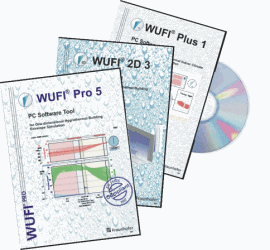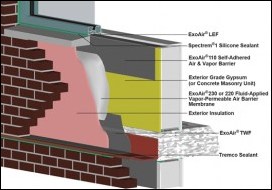
by Brianna Crandall — November 21, 2012—BuildingGreen, Inc., publisher of the GreenSpec directory of eco-friendly products and materials and the Environmental Building News (EBN) sustainable design and construction magazine, has announced the company’s selection of the Top-10 Green Building Products for 2013. The eleventh annual awards, announced at the U.S. Green Building Council’s Greenbuild Conference in San Francisco, are BuildingGreen’s editors’ picks of the most innovative green building products, drawn from product reviews published in GreenSpec and EBN.
“After a year of record droughts and floods across the country, this year’s Top-10 products include several for managing moisture in buildings or for irrigating more responsibly,” says BuildingGreen founder and GreenSpec executive editor Alex Wilson. “In selecting this year’s products, we looked for companies addressing resilience, energy efficiency, thoughtful use of materials, cutting-edge system optimization, and other needs.”
This year’s selections include software for modeling heat and moisture flows, concrete masonry units with sequestration of carbon dioxide, a low-emissions coating for windows that opens new possibilities to energy-efficient, passive solar windows, and a light-emitting diode (LED) streetlight meant to deliver 100 lumens per watt to precisely the area where the light is needed.
The 2013 selections highlight the role of building science and system-level thinking in driving today’s green product innovations, says BuildingGreen. Tremco’s Engineered Transition Assembly, for example, integrates membranes, sheathings, and more with a focus on corners and connections, and WUFI software lets builders model the movement of heat and moisture for various materials and scenarios to fine-tune all aspects of a building assembly.
The Leadership in Energy and Environmental Design (LEED) rating systems from the U.S. Green Building Council (USGBC) also continue to encourage development of green products; GreenSpec users can find products organized by LEED credits as well as by building category and the CSI MasterFormat structure.
BuildingGreen’s Top-10 Green Building Products for 2013 are listed below. More complete descriptions follow for products that are particularly pertinent to facilities management, and descriptions for the others are available on the awards Web page.
- WUFI software from Fraunhofer IBP and Oak Ridge National Laboratory
- Atlas CMU block with CarbonCure
- Amorim expanded-cork boardstock insulation
- Proglaze ETA Engineered Transition Assemblies from Tremco Commercial Sealants & Waterproofing
- LoE-i89 glazing from Cardinal Glass Industries
- Viridian Reclaimed Wood
- GeoSpring hybrid electric water heater from GE
- Haiku by Big Ass Fans
- XS-P Series streetlight from Cree Lighting
- Cyber Rain irrigation controllers
WUFI (“Wärme and Feuchte Instationär,” or transient heat and moisture) is a family of sophisticated PC-based software tools developed by Fraunhofer Institute for Building Physics (IBP) in Germany and Oak Ridge National Laboratory in Tennessee to model how moisture moves through building assemblies. The software calculates heat and moisture transfer in multilayer building components exposed to various climate conditions, and has been used in the development of smart vapor retarders. Among WUFI’s uses are assessing the performance of roof or wall assemblies in driving rain; estimating the drying time of masonry with trapped moisture; predicting the impact of repairs; and sensitivity analysis for material substitutions. The product is considered green because it can help prevent moisture or air quality problems.

Amorim’s Expanded Insulation Cork Board is 100% natural, rigid insulation material produced from natural cork, which is bark from a Mediterranean oak tree that can reportedly be harvested every nine years without damaging the trees. Most of Amorim’s cork forests are FSC-certified and the company’s facilities FSC chain-of-custody certified. Amorim processes the cork without the use of artificial binders, retardants or other chemicals. According to the company, the resulting material insulates to R-3.6 per inch, offers excellent acoustic control, is highly durable, has moderate vapor permeability, and meets European fire safety requirements without flame retardants. This product is considered green because it is made of certified wood, is biobased and sustainably sourced, and is durable or low maintenance. It also avoids hazardous ingredients and helps reduce heating and cooling loads. Relevant LEED Credits are: EA Prerequisite 2 — Minimum Energy Performance; MR Credit 6 — Rapidly Renewable Materials; and MR Credit 7 — Certified Wood.

For commercial building applications, Proglaze ETA Engineered Transition Assemblies from Tremco Commercial Sealants & Waterproofing is a complete system comprised of Tremco sealants, membranes, primers, and flashings, as well as insulation and sheathings from other manufacturers, designed to integrate well together to control moisture and heat flow. These aluminum and silicone components are designed to bridge between windows and other wall openings and sheet membranes in the field of the assembly, and are made to last 50 to 100 years. Tremco says it works with design firms to ensure proper use of the ETA and offers an industry-first warranty on its performance. Third-party testing shows minimal air leakage and water vapor transmission and a low VOC content, and all components are Greenguard Children and Schools certified. The aluminum components are 60% recycled. This phthalate-free product is considered green because it is made of low-emitting materials and is durable or low maintenance, and it can help reduce heating and cooling loads and prevent moisture or air quality problems. Relevant LEED Credits are: EA Prerequisite 2: Minimum Energy Performance: Design & Construction; and EA Credit 1: Optimize Energy Performance: Design & Construction
LoE-i89 glazing from Cardinal Glass Industries is a sputtered indium tin oxide low-emissivity (low-e) hard-coat that can be installed on an exposed surface of an insulating glass unit (IGU). This option allows two low-e coatings to be used on a double-glazed IGU, and it reportedly enables a double-glazed window to achieve a level of performance that was previously achievable only with triple-glazing. In certain configurations, a unit U-factor as low as 0.20 can be achieved. Very high light transmittance means that this coating can be appropriate for glazing applications where solar gain is desired. The LoE-i89 product is being used on tempered glass currently and will become fully available on all glass types, including annealed glass, in 2013 (replacing LoE-i81). This product is considered green because it can help reduce heating and cooling loads. The LEED Credit it is relevant to is EA Credit 1: Optimize Energy Performance: Design & Construction.

Haiku ceiling fans, manufactured by Big Ass Fans, have brushless, electronically commutated DC motors for increased energy efficiency and silent operation. Designed for both residential and commercial applications such as hotel rooms, group fitness areas, and classrooms, these elegantly minimalist fans use 2-30 watts, significantly exceeding Energy Star requirements. The sleek, 60-inch-diameter blades are made from either an advanced composite material in black or white, or hand-finished, laminated bamboo in a caramel or cocoa finish. The fans can spin in reverse, and they come with an LED display and remote control as well as a limited lifetime warranty. This product is considered green because it conserves energy. Relevant LEED Credits are: EA Prerequisite 2: Minimum Energy Performance: Design & Construction; EA Credit 1: Optimize Energy Performance: Design & Construction; EA Prerequisite 2: Minimum Energy Efficiency Performance; EA Credit 1: Optimize Energy performance; and EA Credit 1.3: Optimize Energy Performance—HVAC.

The XSP Series LED street and area light from Cree incorporates the company’s LED light engines and BetaLED’s NanoOptic Precision Delivery Grid optics to deliver 100 lumens per watt of either 4000K or 5700K light precisely onto the ground where needed. The XS-P is designed to be affordable, with a payback of as little as three years, yet it is compatible with dimming drivers and is available with optional occupancy sensors, remote monitoring, and other lighting controls. Standard models deliver 3500 and 7000 lumens at 4000K, respectively, and high-efficiency models are 4806 and 9612 lumens. The lights have a lumen maintenance (L70) of over 100,000 hours; meet the IES test for backlight, uplight, and glare; and come with a five-year warranty. This product is considered green because it is durable or low-maintenance, and conserves energy. Relevant LEED Credits are: SS Credit 8: Light Pollution Reduction; EA Prerequisite 2: Minimum Energy Performance; EA Credit 1: Optimize Energy Performance; EA Credit 1.1: Optimize Energy Performance—Lighting Power; and MR Credit 4: Sustainable Purchasing—Reduced Mercury in Lamps.





